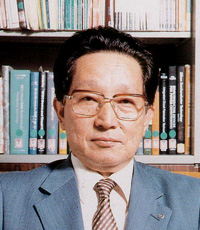Japanese Pioneers
Tetsuo Tsukamoto

Tetsuo Tsukamoto was born in Taiwan in 1922. He graduated from the physics department in the Faculty of Science at Osaka Imperial University in 1944 , and went to work for the Tokyo Telecommunications Engineering Company in 1946. In 1954, he was placed in charge of making crystals to be used as grown transistors in transistor radios. He became deputy general manager of Sony Corporation’s Atsugi Factory in 1964. After terms as deputy director of the Sony Corporation Research Center from 1971 and as president of Sony Shohoku College from 1976, he retired from the company in 1980.
Description of the Process of Implanting Phosphorus for Grown Germanium Transistors
On Kazuo Iwama’s return from the U.S.A. in April of 1954, the Tokyo Telecommunications Engineering Company decided to produce grown transistors for high-frequency operations in transistor radios. Tsukamoto was placed in charge of this project. The production of transistors started immediately after completion of the design and manufacture of the crystal-pulling equipment. The transistors were employed in the TR-55, Japan’s first transistor radio, which hit the market in August of 1955.
Despite the increasing production and sales of the radios, however, the poor yield of transistors for their local oscillators presented a problem in the production of semiconductor devices. Accordingly, Tsukamoto tried phosphorus, which has the lowest atomic number among the Group-5 elements, as the impurity in the emitter. The much lower diffusion coefficient for phosphorus in germanium than that for antimony led to a finished transistor that was a masterpiece in terms of both high-frequency characteristics and high yield.
Despite the change to the method of production, the company remained in a plight as zero yields continued to be observed. Tsukamoto asked Leo Esaki to examine the transistor. On doing so, Esaki found the forward tunneling effect in semiconductor pn-junction diodes. At the same time, it turned out that a solution to the problem lay in optimizing the concentration of phosphorus. Tsukamoto came up with the idea of incorporating a compound semiconductor called indium phosphide (InP) into melting germanium, and the experiment turned out successful since it was found that the segregation of indium prevented it entering the transistor. The key to success was accurately determining the weight of indium phosphorus to be implanted. This all happened in the spring of 1957, and gave Sony an edge in the field of transistor radios.


